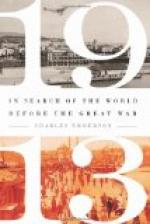Neither Germans nor Englishmen were careful before the war always to be pleasant to each other, and the same used to be true of Frenchmen and Englishmen. But just as we are coming to understand why and how France and England misinterpreted each other systematically a century and a half ago, so we may yet learn how we came to present, more than a hundred years later, difficulties to the Germans not wholly unlike those which they presented to us. No mere record of the dry facts will be enough to render this intelligible in its full significance. The historian who is to carry conviction must do more than present photographs. He must create a picture inspired by his own study and from the depth of his own mind, and presented in its real proportions with its proper lights and shadows, as a true artist alone can present it. Browning has told us something worth remembering. It is at the end of “The Ring and the Book”:
Art
may tell a truth
Obliquely, do the thing shall
breed the thought,
Nor wrong the thought, missing
the mediate word.
So may you paint your picture,
twice show truth,
Beyond mere imagery on the
wall,—
So, note by note, bring music
from your mind,
Deeper than ever e’en
Beethoven dived,—
So write a book shall mean
beyond the facts,
Suffice the eye and save the
soul beside.
The truth in its fulness and completeness can not be compassed in any single narrative of events. It is, of course, the case that history depends for its value on scientific accuracy, but that is not the only kind of truth on which it depends. No man, even the most careful and exacting, can rely on having the whole of the materials before his eye, and if he had them there they would not only be presented in tints depending on his outlook, but would be too vast to admit of his using more than isolated fragments to work into his picture of the whole. Selection is a necessity, and when to the fact that there must be selection there is added the other fact that every historian has his personal equation, the notion of a history constructed by a single man on the methods of the physicist is a delusion. The best that the great historian can do is to present the details in the light of the spirit of the period of which he is writing, and in order that he may present his narrative aright, as his mind has reconstructed it, he must estimate his details in the order in importance that was actually theirs. Now for this the balance and the measuring rod do not suffice. Quality counts as much as does quantity in determining importance. What is merely inert and mechanical is the subject neither of the artist nor the historian. It is, of course, necessary that by close and exact research the materials should first of all be collected and assembled. But that is only the first step, and it always has to be followed by a process of grouping and fashioning. The result may have to be the




